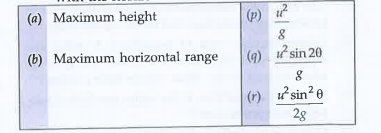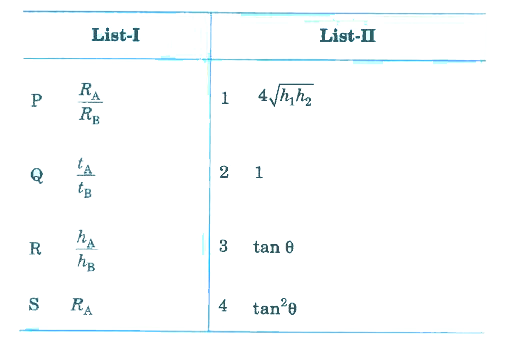Find the average velocilty of a projectile between the instants it crosses half the maximum height. It is projected with speed u ast angle θ with the horizontal.
To find the average velocity of a projectile between the instants it crosses half the maximum height, we can follow these steps:
1. Understand the Motion of the Projectile:
- A projectile is launched with an initial speed u at an angle θ to the horizontal. The motion can be separated into horizontal and vertical components.
2. Determine the Maximum Height:
- The maximum height H of the projectile can be calculated using the formula:
H=u2sin2θ2g
where g is the acceleration due to gravity.
3. Calculate Half the Maximum Height:
- Half of the maximum height is:
H2=u2sin2θ4g
4. Find the Time to Reach Half the Maximum Height:
- The time t1 to reach half the maximum height can be found using the vertical motion equation:
y=uyt−12gt2
where uy=usinθ is the vertical component of the initial velocity.
- Setting y=H2:
u2sin2θ4g=(usinθ)t1−12gt21
- Rearranging gives a quadratic equation in t1.
5. Find the Time to Descend Back to Half the Maximum Height:
- The projectile will also cross half the maximum height on its way down. The time t2 to reach this point after reaching the maximum height can be calculated similarly. The total time to reach this point again will be t1+t2.
6. Calculate the Horizontal Displacement:
- The horizontal displacement x during the time interval from t1 to t2 can be calculated using:
x=ux(t2−t1)
where ux=ucosθ is the horizontal component of the initial velocity.
7. Determine the Average Velocity:
- The average velocity Vavg between the two instants is given by:
Vavg=Total DisplacementTotal Time=xt2−t1
- Since the horizontal component of velocity ucosθ remains constant, the average velocity can be directly stated as:
Vavg=ucosθ
Final Answer:
The average velocity of the projectile between the instants it crosses half the maximum height is:
Vavg=ucosθ
- A projectile is launched with an initial speed u at an angle θ to the horizontal. The motion can be separated into horizontal and vertical components.
- The maximum height H of the projectile can be calculated using the formula:
H=u2sin2θ2g
where g is the acceleration due to gravity.
- Half of the maximum height is:
H2=u2sin2θ4g
- The time t1 to reach half the maximum height can be found using the vertical motion equation:
y=uyt−12gt2
where uy=usinθ is the vertical component of the initial velocity.
- Setting y=H2:
u2sin2θ4g=(usinθ)t1−12gt21
- Rearranging gives a quadratic equation in t1.
- The projectile will also cross half the maximum height on its way down. The time t2 to reach this point after reaching the maximum height can be calculated similarly. The total time to reach this point again will be t1+t2.
- The horizontal displacement x during the time interval from t1 to t2 can be calculated using:
x=ux(t2−t1)
where ux=ucosθ is the horizontal component of the initial velocity.
- The average velocity Vavg between the two instants is given by:
Vavg=Total DisplacementTotal Time=xt2−t1
- Since the horizontal component of velocity ucosθ remains constant, the average velocity can be directly stated as:
Vavg=ucosθ
The average velocity of the projectile between the instants it crosses half the maximum height is:
Vavg=ucosθ
Topper's Solved these Questions
- REST AND MOTION : KINEMATICSBOOK - HC VERMACHAPTER - REST AND MOTION : KINEMATICSEXERCISE - Objective 2
10 Videos
- PHYSICS AND MATHEMATICSBOOK - HC VERMACHAPTER - PHYSICS AND MATHEMATICSEXERCISE - Exercises
34 Videos
- ROTATIONAL MECHANICSBOOK - HC VERMACHAPTER - ROTATIONAL MECHANICSEXERCISE - Exercises
86 Videos
Similar Questions
For a projectile first with velocity u at an angle θ with the horizontal.

View SolutionWhat is the radius of curvature of the parabola traced out by the projectile in which a particle is projected with a speed u at an angle θ with the horizontal, at a point where the velocity of particle makes an angle θ/2 with the horizontal.
View Solution
Knowledge Check
A stone projected with a velocity u at an angle (theta )with the horizontal reaches maximum heights H1. When it is projected with velocity u at an angle (π2−θ) with the horizontal, it reaches maximum height H2. The relations between the horizontal range R of the projectile, H1andH2, is
AR=4√H1H2BR=4(H1−H2)CR=4(H1+H2)DR=H21H22A stone projected with a velocity u at an angle q with the horizontal reaches maximum heights H1. When it is projected with velocity u at an angle (π2−θ) with the horizontal, it reaches maximum height H2. The relations between the horizontal range R of the projectile, H1andH2, is
AR=4√H1H2BR=4(H1−H2)CR=4(H1+H2)DR=H21H22Find the angle of projection of a projectile for which the horizontal range and maximum height are equal.
Aα=tan−1(2)Bα=tan−1(4)Cα=tan−1(5)DNone of the above
A particle is projected with velocity u at angle θ1 with horizontal .The ratio of range and maximum height is 4. When it is projected at angle θ2 with horizontal with same speed,the ratio of range and maximum height is 2.Then tanθ1tanθ2 will be equal to
View SolutionParticle A is projected with speed u at an angle θ with the horizontal . Another particle B is also projected with same speed u at an angle 90−θ with the horizontal . Both the projectiles are fired from the ground and reaches the ground after completing the projectile . Time of flight for A is tA and that for B it is tB. Range of the projectile A is RA and that for B is RB . Maximum height reached by the projectile A is hA and that for B is hB

View SolutionIf R and H represent horizontal range and maximum height of the projectile, then the angle of projection with the horizontal is
View SolutionThe horizontal range of a projectile is times of its maximum height. Its angle of projection will be :-
View SolutionA stone projected from ground with certain speed at an angle θ with horizontal attains maximum height h1 when it is projected with same speed at an angle θ with vertical attains height h2. The horizontal range of projectile is
View Solution
